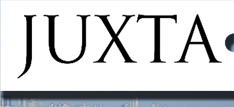



 |
| Author's Guide | |
1. Notes to Contributors
2. Article Submission
3. Style GuidelinesNotes to Contributors:
Juxtaposition is a journalistic global health magazine and publishes submissions from all discipline. We are interested in issues that highlight the interconnectivity of health and disease, social inequalities, and marginalized and vulnerable populations. This may be looked at through the lens of commerce, law, culture, medicine, policies, anthropology, or political science…etc.The magazine seeks to promote an open forum for student-led dissemination of global health information to raise awareness of global health issues among the University of Toronto community. We want Juxtaposition to be a compelling, must-read publication that students and others recognize as a trusted and current source of relevant information, delivered in an open and honest manner.
The magazine’s objective is not to be the first student magazine to carry the "news" per se (like Reuters), but rather to explain the broader contexts and controversies around news events that relate to global health.
The tone and voice of Juxtaposition is similar to that of the New York Times: although the writing style is not informal, it can be personal and written in the first person. In order to appeal to a general audience, we prefer concise, clear sentences and avoid overly specialist language pertaining to any one discipline. If an uncommon specialist term is used, a definition must always be provided. For ease of scanning, articles should be presented in short paragraphs. Furthermore, whenever possible, we suggest the use of direct sentence construction rather than passive, to emphasize an active voice.
ARTICLE SUBMISSION
Manuscripts should be submitted electronically by email attachment in MSWord only. Currently, Juxtaposition accepts only manuscripts in English.
Manuscripts should be sent to the attention of Ms. Kadia Petricca, Editor-in-Chief at: eic.juxtaposition.uoft*gmail.comNote: To lessen somewhat problems with spam, email addresses are disguised with * instead of the @ sign
The email accompanying the manuscript must include the author’s name, article title, and a total word count of article (excluding abstract, notes, and bibliography).
STYLE GUIDELINES
Format: The manuscript (abstract, notes and bibliography excluded) should not normally exceed 1200 words and should be in 12 point-font Times New Roman typeface. The name of the author must appear only on the title page. Submissions should be left justified.Title Page: Please indicate title, author, institutional affiliation, email address and a brief autobiography of no more than 50 words.
Subheadings: Subheadings should be bolded and not indented. Required headings include: "Abstract," "References" (or bibliography) and "Notes".
Abstract and Keywords: Manuscripts must be accompanied by an abstract not exceeding 250 words. Abstracts and the title of the manuscript should be followed by the text on the same page. A list of 3 keywords in square brackets must follow the abstract. Please consult Sample Abstract for guidelines.
Citation/Notes: All notes and citations must follow the text as endnotes and must be in 12 point font.
References: The bibliography should appear after the endnotes on a separate page. Authors should use the Chicago style of referencing which follows:
Book:
Irwin, Alexander, Joyce Millen and Dorothy Fallows. 2003. Global AIDS: Myths and Facts. Cambridge: South End Press.Journal Article:
Howard, R. E. 1993. Cultural Absolutism and the Nostalgia for Community. Human Rights Quarterly 15 (2): 315:338.Book Chapter:
Baer, Hans A., Merrill Singer, and Ida Susser. 2003. Biomedical Hegemony in the Context of Medical Pluralism. IN Medical Anthropology and the World System. Pp 329-352. Westport, CT: Praeger.Acknowledging Sources and Avoiding Plagiarism
While Juxtaposition is not an academic journal and submissions are not academic essays, sources and direct quotations should still be acknowledged. The long-standing and well-known approaches to avoiding plagiarism which are familiar to all students should be kept in mind. The editors reserve the right to exclude any article that includes plagiarized material.
If you need a refresher on how to avoid plagiarism, have a look at Dr. Margaret Procter's "How to Not Plagarize."
Last Updated: February 26, 2007